Calorimetry: VP-ITC, Auto-iTC200, VP-DSC, and Auto-PEAQ-DSC (MicroCal, Malvern-Panalytical)
What are the sample requirements?
- Pure samples are required.
- For a typical DSC assay, you might need 0.5 mL of 20 μM protein solution.
- For a typical ITC assay, you might need 0.5 mL of 10-20 μM protein solution and 0.15 mL of 100-200 μM of ligand solution.
What other specific considerations are relevant?
- It is important that protein and ligand solutions are perfectly matched regarding buffer composition.
- Avoid large concentration of solubilizing agents (e.g., glycerol, DMSO) and reducing agents (e.g., DTT, TCEP).
- Buffers with low ionization enthalpy are preferred for DSC.
- Please contact for specific details on the experimental protocol.
- Contact person: Adrian Velazquez-Campoy ()
Surface plasmon resonance: Biacore T200 (GE Healthcare)
What are the sample requirements?
- Pure samples are required.
- The attachment of the macromolecule of study to a functionalized surface (SPR chip) is required.
What other specific considerations are relevant?
- Please contact for specific details on the experimental protocol.
- Contact person: Adrian Velazquez-Campoy ()
Microscale thermophoresis: Monolith NT.115Pico (NanoTemper)
What are the sample requirements?
- Pure samples are required.
- The attachment of an appropriate fluorophore probe to the macromolecule of study is required.
What other specific considerations are relevant?
- Please contact for specific details on the experimental protocol.
- Contact person: Adrian Velazquez-Campoy ()
Spectroscopy: Chirascan spectropolarimeter (Applied Photophysics), Cary Eclipse fluorimeter (Agilent), NanoStar DynaPro DLS and DynaPro Plate Reader III (Wyatt Technology)
What are the sample requirements?
- Pure samples are required.
- For a typical assay you might need as much as 0.8 mL of 10 μM protein solution (e.g., near-UV circular dichroism measurement), and as little as 0.05 mL of 5 μM protein solution (e.g., DLS measurement).
What other specific considerations are relevant?
- Please contact for specific details on the experimental protocol.
- Contact person: Olga Abian ()
Multimode plate readers: FluoDia T70 (PTI), Synergy HT (BioTek), Mx3005p (Agilent), CLARIOStar and FLUOStar (BMG Labtech)
What are the sample requirements?
- Pure samples are required (for proteins and chemical compounds).
- You may need specific cell lines in order to observe cell-specific effects.
- For a typical assay you might need as less as 0.1 mL of 0.2 μM protein solution (e.g., enzymatic reaction) or as much as 0.1 mL of 2 μM protein solution (e.g., differential scanning fluorimetry).
What other specific considerations are relevant?
- Please contact for specific details on the experimental protocol and amount of sample required.
- Contact person: Nunilo Cremades (), Olga Abian ()
Fluorescence microscopy: DMI 6000B (Leica)
What are the sample requirements?
- Pure samples are required (for proteins and chemical compounds).
- You may need specific cell lines in order to observe cell-specific effects.
- Proteins can be introduced into cells, but usually cells are transiently transfected with DNA constructs that code for the desired protein, either alone of fused to fluorescent proteins.
- Specific stable cell lines expressing the protein of interest can also be generated and analysed.
What other specific considerations are relevant?
- The attachment of an appropriate fluorophore probe to the macromolecule of study is required for live cell experiments.
- For immunocytochemistry, specific antibodies are required.
- Fluorescently labelled ligands can also be used.
- Please contact for specific details on the experimental protocol.
- Contact person: Jose Alberto Carrodeguas ()
Single molecule spectroscopy: MicroTime 200 (PicoQuant)
What are the sample requirements?
- Highly pure samples are required.
- Standard measurements are performed with 50 μL of 200 pM labelled protein for single-molecule experiments or 1 nM for fluorescence correlation spectroscopy measurements.
What other specific considerations are relevant?
- The attachment of an appropriate fluorophore probe to the macromolecule of study is required.
- Please contact for specific details on the experimental protocol
- Contact person: Nunilo Cremades (ncc@unizar.es)
